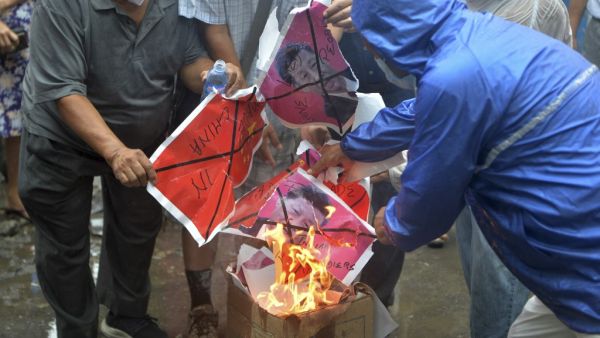China has diverted the Galwan river to claim more territory in its heated border dispute with India, it has been claimed.
The confrontation in the Galwan Valley, part of the disputed Ladakh region along the Himalayan frontier, was the deadliest between the two countries in 45 years.
Analysis now reportedly shows how China altered the Galwan river's ecosystem to claim the territory as its own.
Satellite images from 2010 show the Galwan Valley area as a narrow stretch with no road infrastructure. China started quietly building roads with compressed earth in 2015-2016, with satellite images showing just one hut with no troop deployments.
In May 2020 the country's People's Liberation Army (PLA) entered the area for a 'military exercise' - and has been assembling troops all along the sides of the river, India Today reports.
Retired Indian Army Colonel Vinayak Bhat wrote that, after realising that large force deployments were not feasible along the waterway, Chinese engineers made a plan to canalise the Galwan river deeper using dozers and JCBs to limit its size.
A dozer seen in satellite images on June 16 was reportedly creating a channel on the northern bank of the river to avoid the need for two bridges.
Pictures indicate that China is claiming the Galwan river's sides up to 25 miles from The Line of Actual Control (LAC) - which separates Indian-controlled territory from Chinese-controlled territory.
Chinese engineers are reportedly altering the river's course and reducing its width so troops can be deployed on the larger land mass - and permanent infrastructure can be constructed.
Satellite images from May 29 show a large build-up of Chinese troops roughly 25 miles east of the Galwan conflict point, it was said.
India blames China for instigating the fight by developing infrastructure in the valley, which it said was a breach of the agreement of what area remained in dispute.
Chinese Foreign Ministry spokesperson Zhao Lijian said in a statement Friday that 'the Galwan Valley is located on the Chinese side of the Line of Actual Control in the west section of the China-India boundary.'
He blamed incursions by Indian troops in the area from early May for a midnight clash on Monday that left 20 Indian soldiers dead. China has not said whether it suffered any casualties.
China says the Galwan Valley high up in the Himalayan border region where Chinese and Indian troops engaged in a deadly brawl this week falls entirely within China, boldly renewing claims on the disputed area as the Asian giants continued using military and diplomatic channels to try to reduce tensions this weekend.
Troops remain locked in a face-off at several locations along the poorly defined Line of Actual Control, despite talks between local commanders to de-escalate.
Soldiers had brawled with clubs, rocks and their fists in the thin air at 14,000 feet above sea level, but no shots were fired, Indian officials have said. The soldiers carry firearms but are not allowed to use them under a previous agreement in the border dispute.
Indian security officials have said the fatalities were caused by severe injuries and exposure to subfreezing temperatures.
The valley falls within a remote stretch of the 2,100-mile Line of Actual Control - the border established following a war between India and China in 1962 that resulted in an uneasy truce.
Indian Ministry of External Affairs spokesperson Anurag Srivastava repeated on Saturday that China's claims to the valley were 'exaggerated and untenable.'
'They are not in accordance with China´s own position in the past. Indian troops are fully familiar with the alignment of the (Line of Actual Control) in all sectors of the India-China border areas, including in the Galwan Valley. They abide by it scrupulously here, as they do elsewhere,' Srivastava said in a statement.
Prime Minister Narendra Modi said in a meeting with political opposition leaders on Friday that no one 'has intruded into our territory, nor taken over any post.'
Modi said India was 'hurt and angry' about the deaths of its troops. He said India wanted peace and friendship, but had the 'capability that no one can even dare look toward an inch of our land.'
Also on Friday, Zhao, the Chinese Foreign Ministry spokesperson, said that China was not holding any Indian soldiers, without addressing media reports that China had released 10 of them late Thursday.
'My information is that at present there are no Indian personnel detained on the Chinese side,' Zhao said, according to an English version of his daily briefing posted on the ministry's website.
Indian officials have denied that any soldiers were in Chinese custody.
This article has been adapted from its original source.








